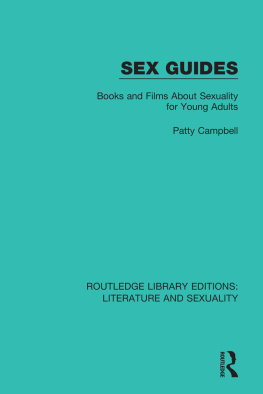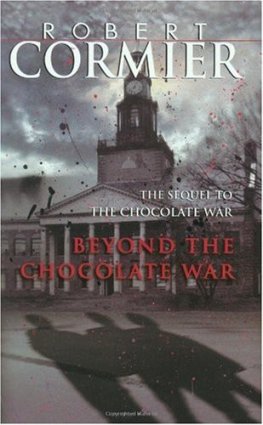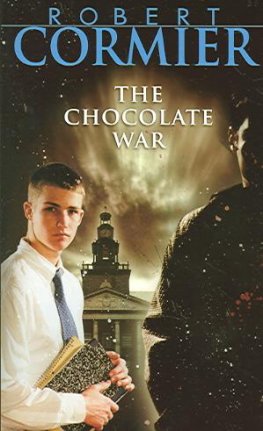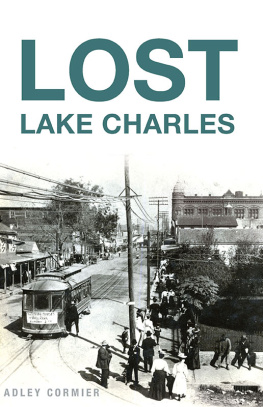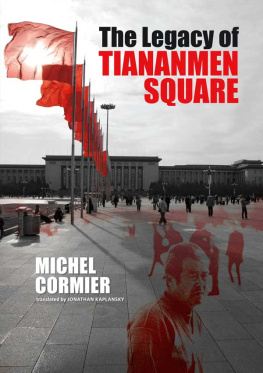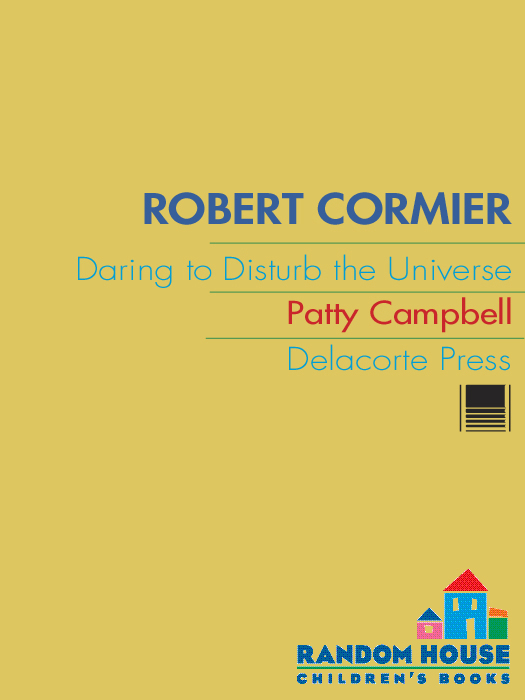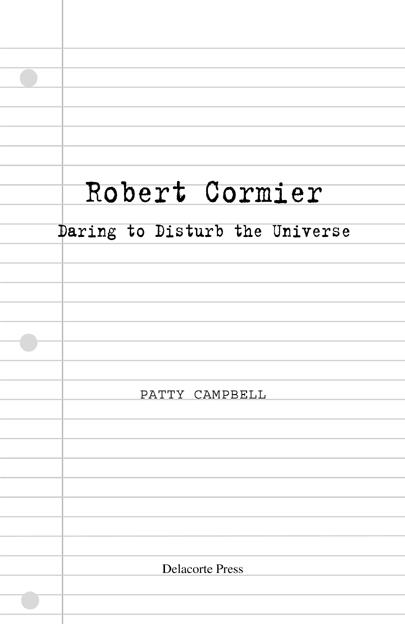Published by Delacorte Press
an imprint of Random House Childrens Books
a division of Random House, Inc.
New York
Text copyright 2006 by Patty Campbell
Sections of this book were first published in Presenting RobertCormier, Twayne Publishers, 1985, 1989, and are reprinted here by permission of the Gale Group.
All rights reserved.
Delacorte Press and colophon are registered trademarks of
Random House, Inc.
www.randomhouse.com/teens
Educators and librarians, for a variety of teaching tools, visit us at www.randomhouse.com/teachers
Library of Congress Cataloging-in-Publication Data
Campbell, Patricia J.
Robert Cormier : daring to disturb the universe / Patricia
Campbell.1st ed.
p. cm.
Includes bibliographical references.
eISBN: 978-0-307-54435-3
(Gibraltar lib. bdg.) 1. Cormier, RobertCriticism and interpretation.
2. Young adult fiction, AmericanHistory and criticism. I. Title.
PS3553.O653Z625 2006
813.54dc22
2005023595
v3.1
Contents
Chapter One
A Disturbing Master and Mentor
Chapter Two
A Life with a Sweet Bonus
Chapter Three
At the Typewriter
Chapter Four
The Chocolate War
Chapter Five
The Dark Chocolate Controversy
Chapter Six
Beyond the Chocolate War
Chapter Seven
I Am the Cheese
Chapter Eight
After the First Death
Chapter Nine
The Bumblebee Flies Anyway
Chapter Ten
Fade
Chapter Eleven
The Younger Novellas: Other Bells for Us to Ring, Tunes for Bears to Dance To, and Heroes
Chapter Twelve
The Middle Novels: We All Fall Down and In the Middle of the Night
Chapter Thirteen
Tenderness
Chapter Fourteen
Last Words: Frenchtown Summer and The Rag and Bone Shop
Appendix I
Robert Cormiers Awards and Honors
Appendix II
Films Based on Robert Cormiers Novels
Acknowledgments
The largest debt of gratitude for the creation of this book is owed to Robert Cormier himself, of course, for his friendship and generosity over the years, and for many good conversations, letters, and e-mails about his writing and his life. His wife, Constance, too, has been a good friend, a gracious presence, and a major help in getting the facts right about the Cormier family. Gratitude is also due the Cormier archives of Fitchburg State College, under the leadership of library director Robert Foley, with special thanks to him and archivist Janice Ouellette for their prompt and complete answers to even the most esoteric questions. Appreciation is also offered to Craig Virden, who first saw the importance of this book as a tribute to the memory of our mutual friend; to Beverly Horowitz, who carried on that conviction; to Karen Wojtyla, who shared stories of her time as Cormiers editor; to Joan Slattery and other staff at Random House Books for Young Readers, who scoured their memories and their files in response to my questions. And finally, many thanks to my editor, Krista Marino, for her respect for Robert Cormier and her help and guidance.
Foreword
The first time I saw Robert Cormier he was standing in a forest behind a pine tree branch. Skulking, I thought. For who but a reclusive, brooding skulker could have written the terrifyingly paranoid I Am the Cheese, a book that I had just finished and that would haunt me for weeks. So there he was on the back flap of the book jacket, just as I pictured him. Later we laughed together at my first suspicions. Because Robert Cormier was a kindly, cheerful, decent sort of person, something I found out in the first five minutes after meeting him when he came to speak to the librarians of the Los Angeles Public Library in 1978.
In the next few years he wrote three more magnificent young adult novels after The Chocolate War and I Am the Cheese, and my admiration for his work grew and grew. So when I got a letter from Ron Brown, the editor of a new series titled Twaynes Young Adult Authors, asking if I would like to write one of the first volumes, I stubbed my toe in my haste to get to the phone and cry, Dibs on Robert Cormier!
The assignment entailed, as I had hoped it would, a trip to Massachusetts to interview him in January 1984. The Cormiers graciously invited me to stay with them for two days. Bob picked me up in Boston, and as we went over the hill to Leominster I had the thrill of a first look at the town where he spent his life and set his stories. Later that night, as I lay in bed in the upstairs guest room, I could hear the clickety-clack of his typewriter below, as he wroteI imaginedyet another great novel.
During the next two days he shared his life, his thoughts, his unpublished manuscripts almost nonstop, often with Connies help and witty comments. He led me on a tour of the streets of Leominster, where he pointed out landmarks in his fictional town of Monument. We visited the public library where he was a trustee and where Adam Farmer fell in love with Amy; drove past the tenements where he grew up and Paul Moreaux faded; smelled the incense and enjoyed the hush in the cathedral that is St. Cecilias in Leominster and St. Judes in Monument; and even went around the back way through the woods to look down at dusk on the football field of the school where Cormiers son Peter refused to sell chocolates and The Chocolate Wars Jerry Renault met the pain of disturbing the universe. The next afternoon while Bob was busy writing, I spent happy hours shuffling through the piles of documents in the Cormier archives at Fitchburg State College, reading letters from editors and fans, and unpublished scenes and unfinished novels. The trip was the beginning of a lifelong friendship, with many visits and long letters and conversations.
Gradually his editors began to trust me with early galleys and even corrected manuscripts of his novels well before they were published. The first reading was for plot, simple abandonment to the pull of the good story. The second reading was betterdiscovering the structure, the hidden meanings and secrets, the underlying themes and shifts in voices that made his work so powerful. Then, after I had let my reactions jell for a few days, would come the best part, the phone call to discuss the new book with its author. With characteristic modesty, Bob was always delighted to hear my praise, intrigued by my questions, good about criticism. He always said, I know I can believe you when you tell me you think something is terrific, because you dont hesitate to say so when you feel something isnt.
One of the greatest joys of my life has been to be Robert Cormiers biographerand his friend. I had the privilege of being one of his confidants about many things in his work, so I know how he struggled with the hard questions in his books; I know how tired he was of the constant censorship attacks; I know how very much he loved his work, his family, and his town; and I know how he cared profoundly about goodness. But most of all I knowand anyone who ever came in contact with him knowsthat Bob Cormier was a great man as well as a great writer. If this book makes even a beginning at giving readers a sense of that beautiful human being and inspiring them to read his books for themselves, I will be content.


